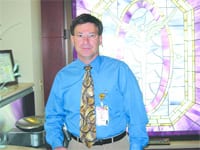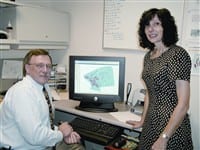Rethinking Radiation State Health Officials Call for More Cancer Treatment Facilities
When trends collide dramatically, people take notice.
Take cancer diagnoses, for example. The Mass. Department of Public Health (DPH) estimates that more than 38,000 people will be diagnosed with cancer in 2010 — an 18{06cf2b9696b159f874511d23dbc893eb1ac83014175ed30550cfff22781411e5} increase over the number diagnosed in 2000.
Meanwhile, Baby Boomers continue to age, lifespans continue to increase, and doctors are diagnosing cancer earlier and treating it more aggressively than ever before. One of their biggest weapons? Radiation.
Once considered a limited tool in the fight on cancer, radiation has taken a huge leap forward with the development of more focused techniques, broadening its potential uses.
So, it’s no surprise that facilities that provide radiation treatment are being challenged by rising demand. Now, the DPH has taken the dramatic step of calling on hospitals to build more cancer centers that include radiation services. The agency says the state needs 68 radiation oncology programs by 2010, but currently has only 60.
Essentially, the DPH has greased the tracks for such facilities by waiving what’s known as the “determination of need,” a process hospitals must typically undergo before adding a new service or expanding an existing service.
“The DPH usually looks at a hospital’s service area and the patient need and demand,” said Paul Wingle, senior director of communications for the Mass. Hospital Association (MHA). Until recently, he said, the agency had set a cap on new applications for radiation oncology.
“The DPH has now lifted the cap and will consider new applications,” he explained. “They see a need, and they want to see more built. And our folks who work with the DPH say the need seems to be greatest in certain regions of the state.”
The two regions that show the strongest need, he said, are Western Mass. and Cape Cod.
“Those are areas where there seems to be a disparity between the number of available facilities and projected patient demand,” Wingle said. “The DPH is particularly concerned about those areas. They see projections showing cancer rates moving forward, and the current limit on treatment facilities to be a problem.”
This month, The Healthcare News explores the factors driving the radiation crunch, and what hospitals are doing about it.
Growing Need
Dr. Wade Gebara is medical director of the Cancer Institute of the Berkshires, located at Berkshire Medical Center in Pittsfield — the only service of its kind in Berkshire County.
“Our patients may have to travel some, especially if they’re coming from the far south or far north, but we’re centrally located in the county, and our region is sparsely populated compared to the eastern part of the state,” Gebara said.
“We have seen some increase in volume over the past five years. It has been gradual, and it’s mainly due to the aging population, but we’re always looking at things we can do to increase our efficiency or improve our equipment to provide for the continuing need.”
The scarcity of radiation treatment options in the outskirts of Western Mass. certainly backs up the DPH’s enthusiasm for more facilities. But for Frank Claudio, director of cancer services at the Sr. Caritas Cancer Center at Mercy Medical Center in Springfield, many questions remain over how tightly regulated any new centers will be.
“I’m not sure what the criteria will be. If you’re going to open eight centers, do you require the same quality you do right now?” Claudio asked, noting that the Caritas Center radiologists are all certified by the American College of Radiology, and the center itself is accredited by the Joint Commission on the Accreditation of Healthcare Organizations — designations that take time and resources to attain.
“If you look at the programs that have been validated, does the standard now change? Does it become less important? Things like that need to be looked into.”
In addition, Claudio noted the ongoing shortage of radiologists in the region, and across America. “By introducing more centers, are you making it even more difficult for centers already operating in this area to attract qualified candidates? And if you put up a new building, would it be the same quality of service as the other cancer centers?”
Cash Crunch
Of course, that’s assuming eight additional treatment centers get built at all. The problem for most hospitals is the cost of building such facilities, particularly at a time when most organizations are strapped for cash.
“Perhaps with the cap relaxed, the free market will dominate, and we’ll see some interest from health care providers,” Wingle said.
“But the upfront costs of building something like that are very, very high. They have to be reinforced to guard against any escape of radiation. Typically a facility like this will cost at least $6 million, even as much as $10 million.”
Claudio looks at the numbers he’s heard — as little as $5 million from some estimates — with skepticism. That’s because treating cancer is more than just installing a machine to direct radiation; patients need to be given access to a wide-ranging, attentive team, he said.
“When patients come in here, they have access to a nurse, a social worker, pastoral care, and more. Maybe it costs $5 million for the building and one machine, but that doesn’t encompass the other costs. Do we want bare minimums? Or is the idea to provide comprehensive services for patients?”
Wingle suggested that hospitals might have to be creative and flexible to make a cancer center work.
“Hospitals might join up with investor-owned companies to partner on something like this,” he said. “Or maybe hospitals with existing sites can look to add capacity or expand.”
That course poses its own pitfalls, Wingle noted, as site requirements for radiation facilities are already strict. “You would need space within an existing facility to build more containment while respecting the site requirements, which prevent you from being too close to areas that are heavily trafficked by the general public. So there are physical restraints as well as economic restraints.”
It Takes Patients
Claudio said the local need for cancer facilities has been on the rise for some time. Before building the Caritas Center, Mercy’s cancer program ran two shifts and was packed for both.
“We were working late into the evening, and spacewise, we didn’t have room — and it wasn’t comfortable for patients to be scheduled late into the evening.”
The Caritas Center better accommodates those needs, he said, and it has been full since the day it opened, boasting such cutting-edge technologies as stereotactic radiosurgery and intensity modulated radiation therapy, or IMRT.
In fact, IMRT — a technology also available at Baystate Health’s nearby D’Amour Center for Cancer Care — demonstrates how changing technology is increasing the need for radiation. IMRT uses computers to produce three-dimensional maps of the treatment area and focuses the radiation like no previous device ever could. That means patients can receive higher doses with minimal risk to healthy surrounding tissue.
But it’s also a sign that radiation is becoming more mainstream. As radiation becomes more targeted, it’s being used as a substitute for surgery in many cancers. Combined with earlier detection of cancer and the fact that people are living longer, it’s easy to understand the increased need for radiation treatment centers — and easy for people like Claudio to foresee a time when they’ll need to expand.
“Established programs like ours already have the support services. You can’t just buy a machine but not have the support services,” he said.
“If you have a program going, it’s easier to add a piece of equipment and grow than it is for someone to start a program from scratch.
“You can get the same quality care here as you can by going to Boston or New York,” he added. “And patients will always want quality care close to home.”
If health officials have their way, that kind of care will someday be close to every home in Massachusetts.


